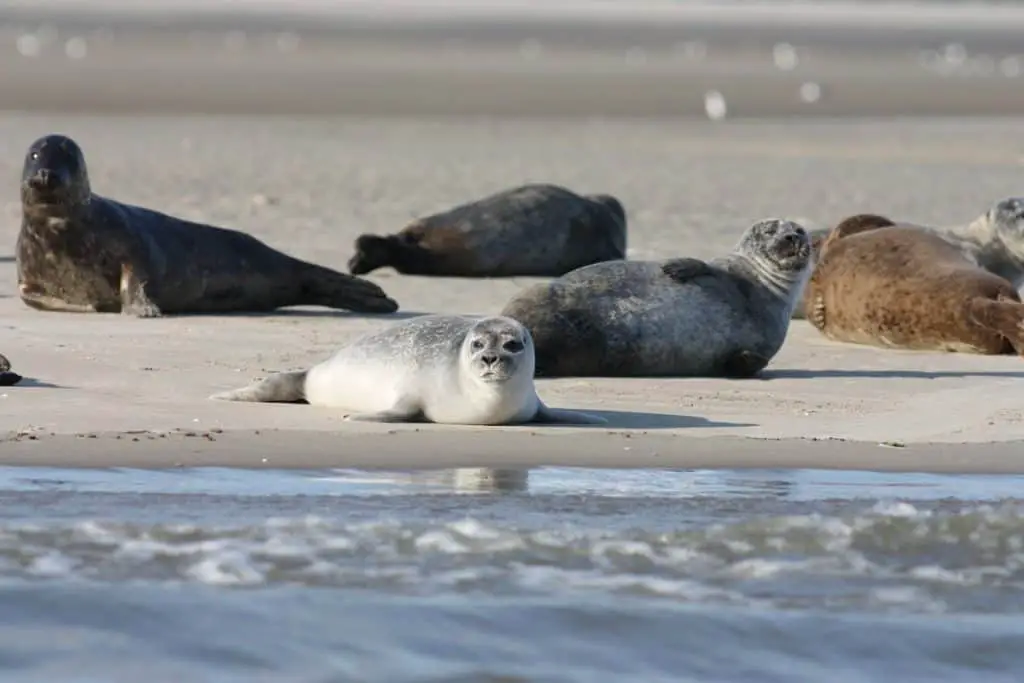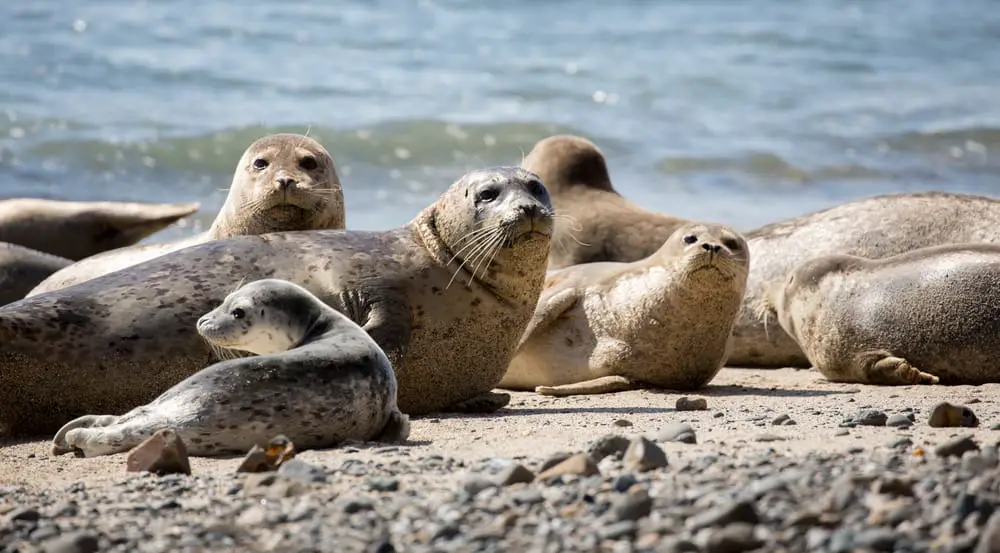The lifecycle of seals is one that has been studied extensively by marine biologists. Seals are considered a keystone species and play an integral part in the balance of aquatic ecosystems around the world.
The stages of development they experience throughout their lives allow them to adapt to changing environmental conditions, making them resilient survivors in challenging environments.
This article will explore the various aspects of seal lifecycle including maternal care, growth rates, predation risks and sexual maturity.

Maternal Care
Marine mammals of the Pinniped family, such as seals, are enchanting animals that offer insight into their fascinating behavior.
The maternal care for these creatures is a critical part of the lifecycle and involves nurturing activities like feeding, fostering behavior, and protection from predators.
Breeding patterns vary among species but all involve some form of parenting between mother and pup.
Mothers will fast while caring for pups during nursing periods, which can last up to 3 weeks in some cases.
During this time they remain with their young defending it from potential threats on land or sea.
Nursing mothers also rely heavily on stored blubber reserves to sustain themselves through fasting.
In addition to protecting pups, mothers teach them important survival skills – helping them learn how to hunt for food and avoid danger when necessary.
This crucial period helps ensure the successful growth of offspring until they become independent enough to venture out on their own.
Growth Rates
The maternal care strategies and behaviors of seals are important to consider when discussing their growth rates. Seals have a variety of feeding strategies which depend on the type of seal, habitat selection, prey availability, and other factors.
For example, some species such as harbor seals feed mainly during the day while others like ringed seals may forage at all hours. Additionally, mother seals must take into account the potential risk from predators in order to keep their pups safe while they hunt.
Growth is an essential part of any life cycle and it is especially crucial for young marine mammals who need enough body fat reserves to survive their first winter. To this end, mother seals concentrate efforts on providing food sources that will give their pups the best chance for successful maturation:
- Nursing – seal milk contains five times more energy than cow’s milk and provides optimal nutrition for growing babies
- Weaning – mothers gradually wean pups off nursing until they can transition onto solid foods
- Foraging – teaching pups how to find food in the wild by following mom’s lead
- Protection – safeguarding against predation through vigilant behavior (e.g., alerting neighbors with loud vocalizations)
- Play – engaging in activities such as chasing games or learning diving techniques helps build physical strength and coordination required for independent hunting later on
Studies conducted on various species demonstrate a positive correlation between maternal parenting styles and pup growth performance; consequently, understanding specific female behaviors is critical when predicting population trends among these animals.
Ringed Seals’ Predators Revealed: Unmasking the Threats
Predation Risks
The predation risks of seal lifecycles is an area that has been studied in detail by marine biologists. Predation, or the act of being eaten by a predator, is a common risk factor to seals and their populations as they traverse different environments throughout their lifetime. Dietary habits and migration patterns can both contribute to this vulnerability.
To further explore these predation risks specifically for harbor, grey and ringed seals – three species with distinct life cycles – Table 1 below illustrates the typical diet consumed through each phase: pups, juveniles, adult males, and adult females. Alongside this data on dietary consumption are notes pertaining to any degree of migratory behavior observed during that stage of development.
The most notable example of migration occurs when juvenile harbor seals travel from nearshore nursery areas to offshore feeding grounds; meanwhile there have been no documented cases of long-distance movement amongst adult female harbor seals. Grey and ringed seals exhibit similar tendencies towards localized movements at various stages within their respective life cycles.
| Predator | Description |
|---|---|
| Great White Shark | Known to prey on seals, especially in coastal areas |
| Killer Whale (Orca) | Predatory marine mammals that target seals as prey |
| Polar Bear | Primarily preys on seals in Arctic regions |
| Sharks (Other Species) | Some shark species may opportunistically target seals |
| Land-based Carnivores | Examples include wolves, bears, and large cats |
| Eagles | Large bird species that may prey on seal pups or injured seals |
| Crocodiles | In some regions, crocodiles are known to attack seals |
| Large Fish | Some large predatory fish may prey on seals |
It’s important to note that the predators listed above can vary depending on the specific geographic region and the seal species involved. Additionally, the type and degree of predation may vary depending on factors such as prey availability, habitat, and predator-prey dynamics.
Sexual Maturity
As adults, seals have to face a new set of risks related to reproduction. In order for their species to continue its existence, they must successfully mate and bring forth offspring.
To do this, adult seals engage in complex breeding behavior and mating rituals that vary depending on the type of seal. For example, some species may require males to compete with each other for access to females while others are promiscuous and form short-term pair bonds between individuals before moving onto different partners.
Regardless of the specific behaviors displayed by any given seal species, they all share one common goal: successful reproduction and continuation of their species population.
Understanding these mating practices is essential for studying how environmental changes affect seal populations over time as well as providing insight into potential conservation strategies for protecting them from further decline or extinction. Research has shown that reproductive failure can be linked to human activities such as pollution or habitat destruction which may disrupt natural behaviors critical for successful mating.
Therefore, understanding more about sexual maturity among seals is key when it comes to preserving their long-term survival in marine environments around the world.

Adaptability To Changing Environments
The seal’s lifecycle is an example of resiliency and adaptability in the face of changing environments. As marine biologists, we strive to understand how these creatures are able to survive despite ever-changing conditions. To do this, it is important to examine two aspects: habitat selection and adaptation to climate shifts.
Habitat selection for seals typically involves a variety of factors such as access to food sources, suitable temperatures for mating, and availability of resting areas. Seals will often move from one environment to another based on these factors when seeking resources or shelter from predators. This ability allows them to inhabit multiple habitats with varying levels of difficulty across their lifetime.
Additionally, they have also adapted over time to changes in temperature caused by climate fluctuations which helps them regulate their body heat while swimming or during hibernation periods.
Seals demonstrate remarkable adaptability as they traverse different environments throughout their lives; this ensures that populations remain healthy even in times of drastic change. Our research into the intricate details of the seal’s lifecycle has revealed its complexity and incredible resilience against environmental stressors.
By studying these animals further, scientists can gain insights into the effects of human activity on our oceans’ delicate ecosystems and better protect vulnerable species like seals from extinction.
Conclusion
The lifecycle of seals is an incredibly fascinating and important process to study. Focusing on the maternal care, growth rates, predation risks, sexual maturity and adaptability to changing environments provides a comprehensive look into their lifecycle habits.
It is clear that understanding the complexities of seal life can help us better understand marine ecosystems as a whole. This type of research is essential for preserving these species and helping them survive in a world where humans are having increasingly drastic effects on their natural habitats.
To ensure we protect our beloved aquatic friends now and in the future, it is imperative that more research be done about the lifecycles of seals. Let’s get out there and do some good!
